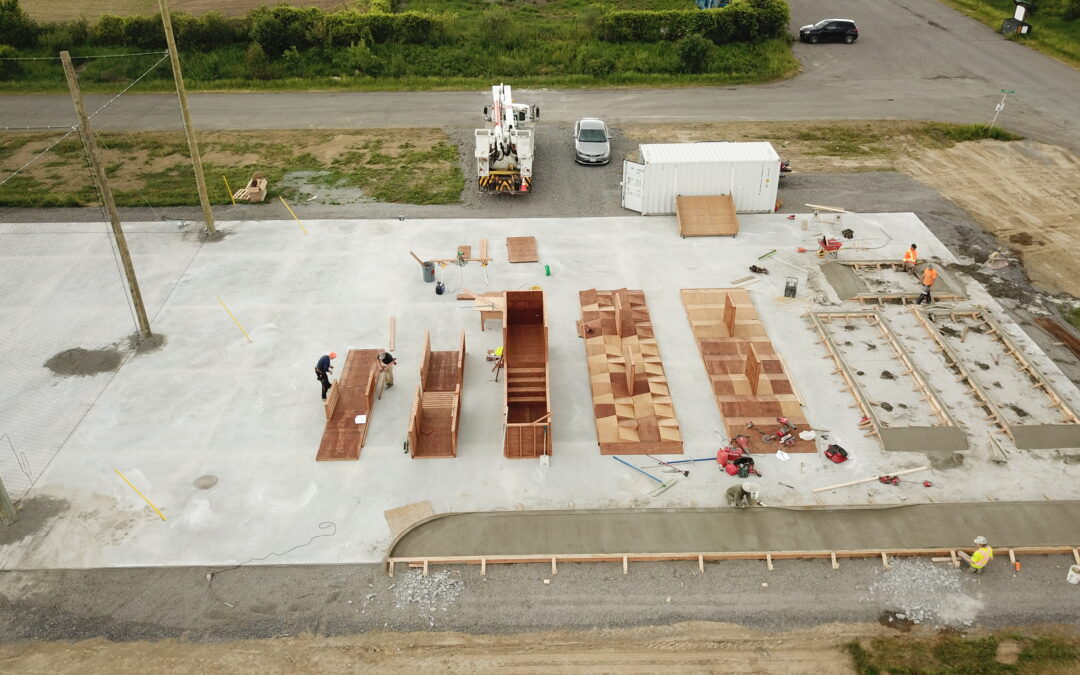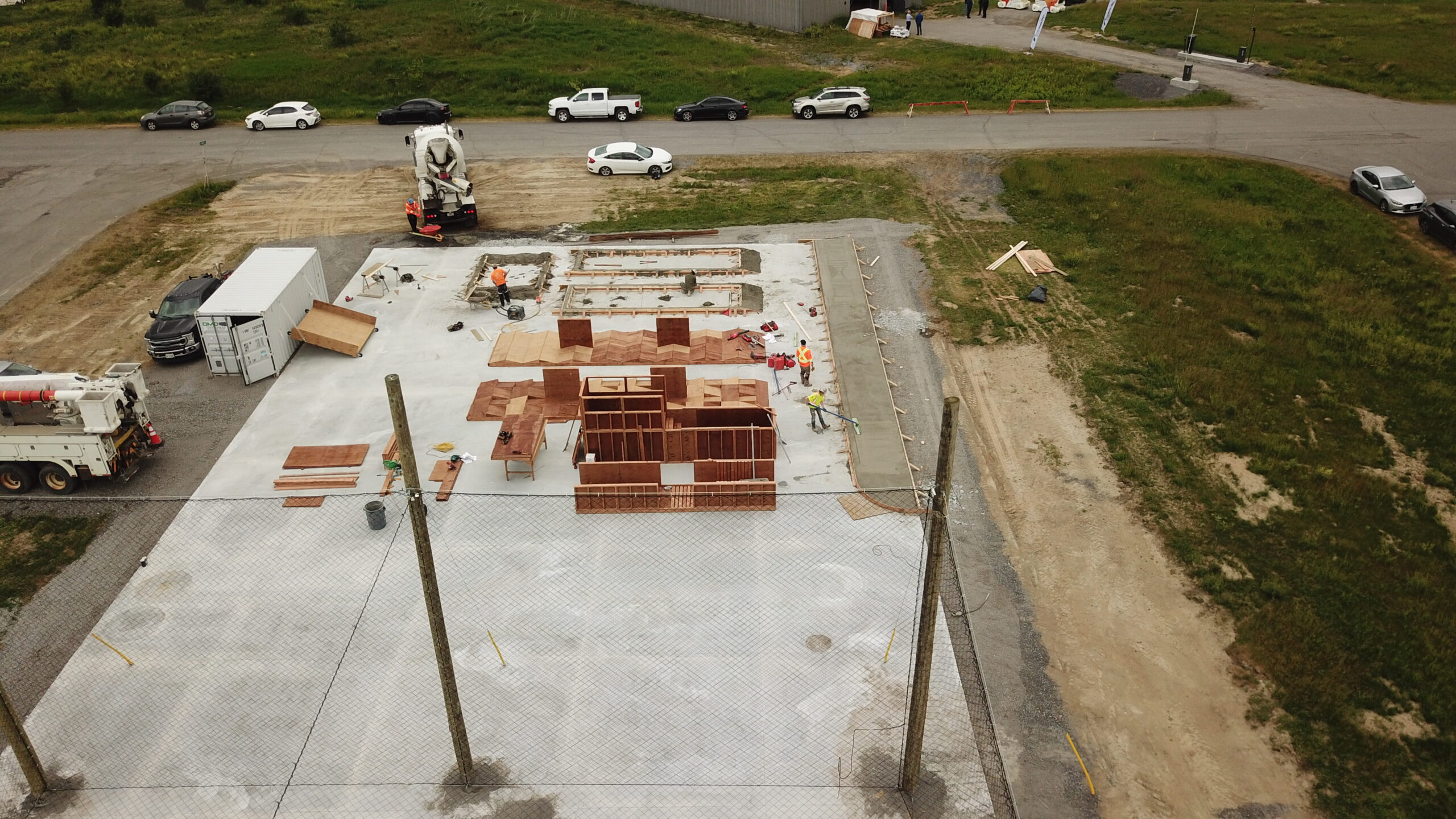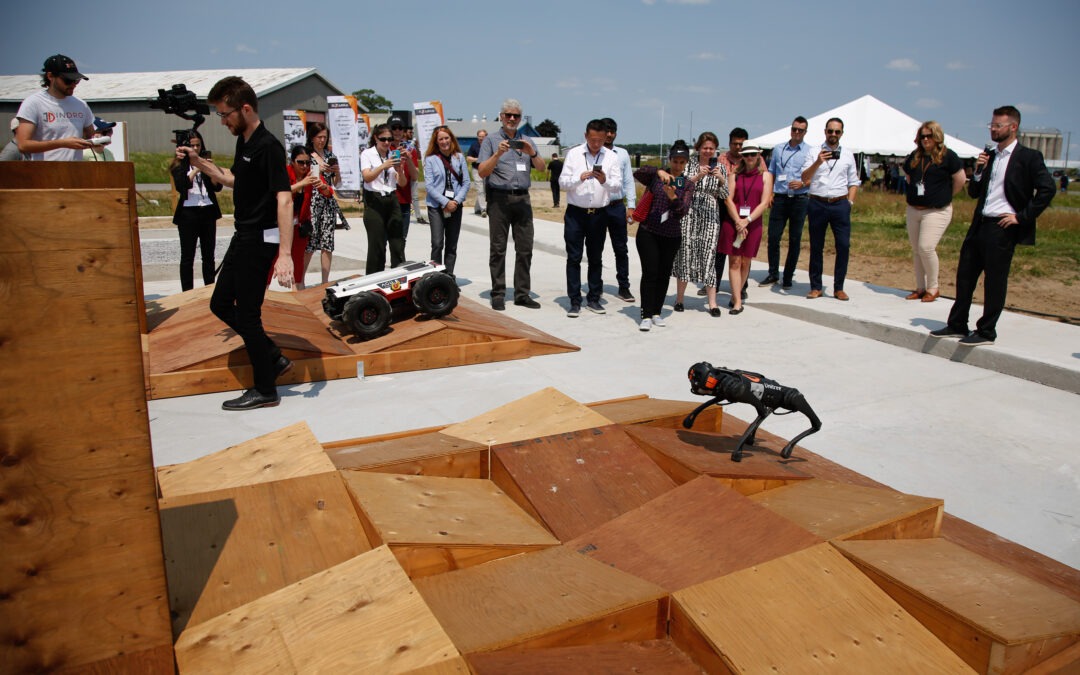
AREA X.O, INDRO ROBOTICS OPEN ‘DARTT’ FOR ADVANCED DRONE AND ROBOT TESTING, TRAINING
By Scott Simmie
Not long ago, it was just an idea.
Today, June 21, the Drone and Advanced Robotics Testing and Training Zone (DARTT) was publicly unveiled with a ribbon cutting ceremony and major public event. It’s the first facility of its kind in Canada.
“This is a huge asset for R&D companies, First Responders and Law Enforcement, Enterprise users – and more,” says InDro CEO Philip Reece. “It’s amazing to see this come to fruition so quickly, and it’s a testament to the strong partnership with – and vision of – Area X.O and Invest Ottawa.”
DARTT has been purpose-built to demanding criteria set out by NIST, the US-based National Institute of Standards and Technology. The goal? To put ground robots, drones and pilots through evidence-based exercises designed to test hardware/software capabilities, as well as human skills. The facility has also been built for high-level training.
The ground robot side features multiple challenging terrains built to evaluate the capabilities of ground robots. There are uneven surfaces, stairways – even an incline ramp that can be changed to different angles to test the ability of robots to climb. There are courses filled with sand, gravel and water to test mobility and Ingress Protection.
And drones? There’s a very large netted enclosure to permit testing of unproven drone technology in a safe environment. Failsafe testing, which can be risky in the wild, can also be accomplished without the need for a Transport Canada Special Flight Operations Certificate.
“The new DARTT Zone at Area X.O will help innovators and companies commercialize new robotic solutions and acquire specialized pilot training and certifications,” says Michael Tremblay, President and CEO of Invest Ottawa, Area X.O, and Bayview Yards.
“This will build Canada’s pool of top tech talent, and help firms get to market, customers, and revenue faster.”
Below: A Scout 2.0 navigates an uneven surface at DARTT
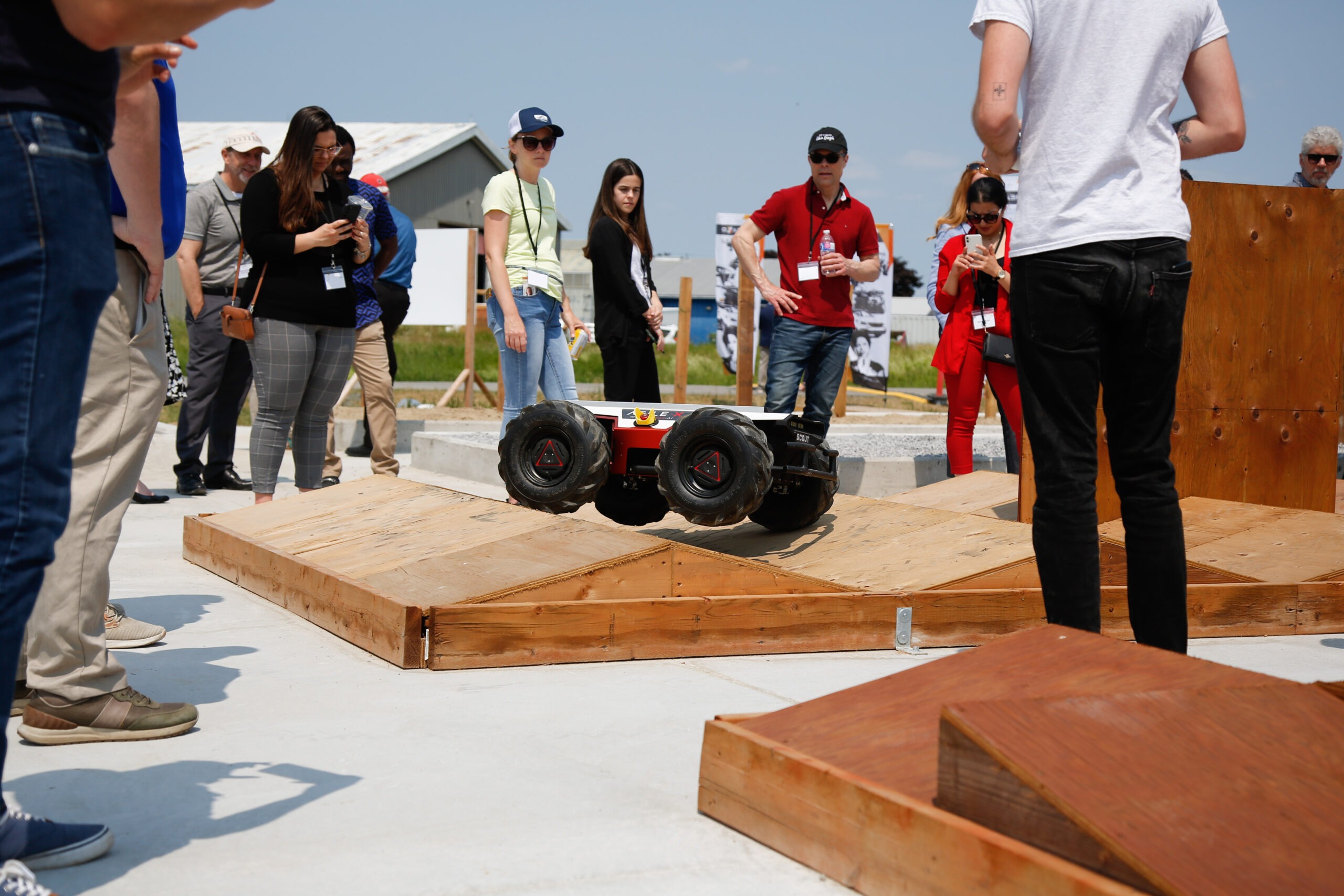
THE BIG REVEAL
Some 200 people registered for the event to officially launch DARTT – including government officials, drone and robotics companies, engineers and even First Responders. They were keen to see first-hand the state-of-the-art facility, funded by the Government of Canada through the Federal Economic Development Agency for Southern Ontario (FedDev Ontario) and in-kind industry contributions from InDro Robotics.
As we reported earlier, the genesis of this project came about through a simple discussion between InDro Robotics CEO Philip Reece and Rebecca Thompson, Senior Manager of Operations at Area X.O.
“It was actually a conversation between (InDro CEO) Philip (Reece) and myself,” explains Thompson. “Having InDro here at Area X.O as one of our tenants and partners – and given the amount of focus on drones and robots in the industry – we asked ‘How do we support these partners? What is Area X.O missing? What can we add on?’”
Reece suggested that an advanced facility for training, testing and evaluation would be of benefit. Such a place would fill a definite void – especially given the tremendous growth in both aerial and ground robots.
“When Philip brought forth the idea it was a no-brainer,” says Thompson.
And now…here we are:
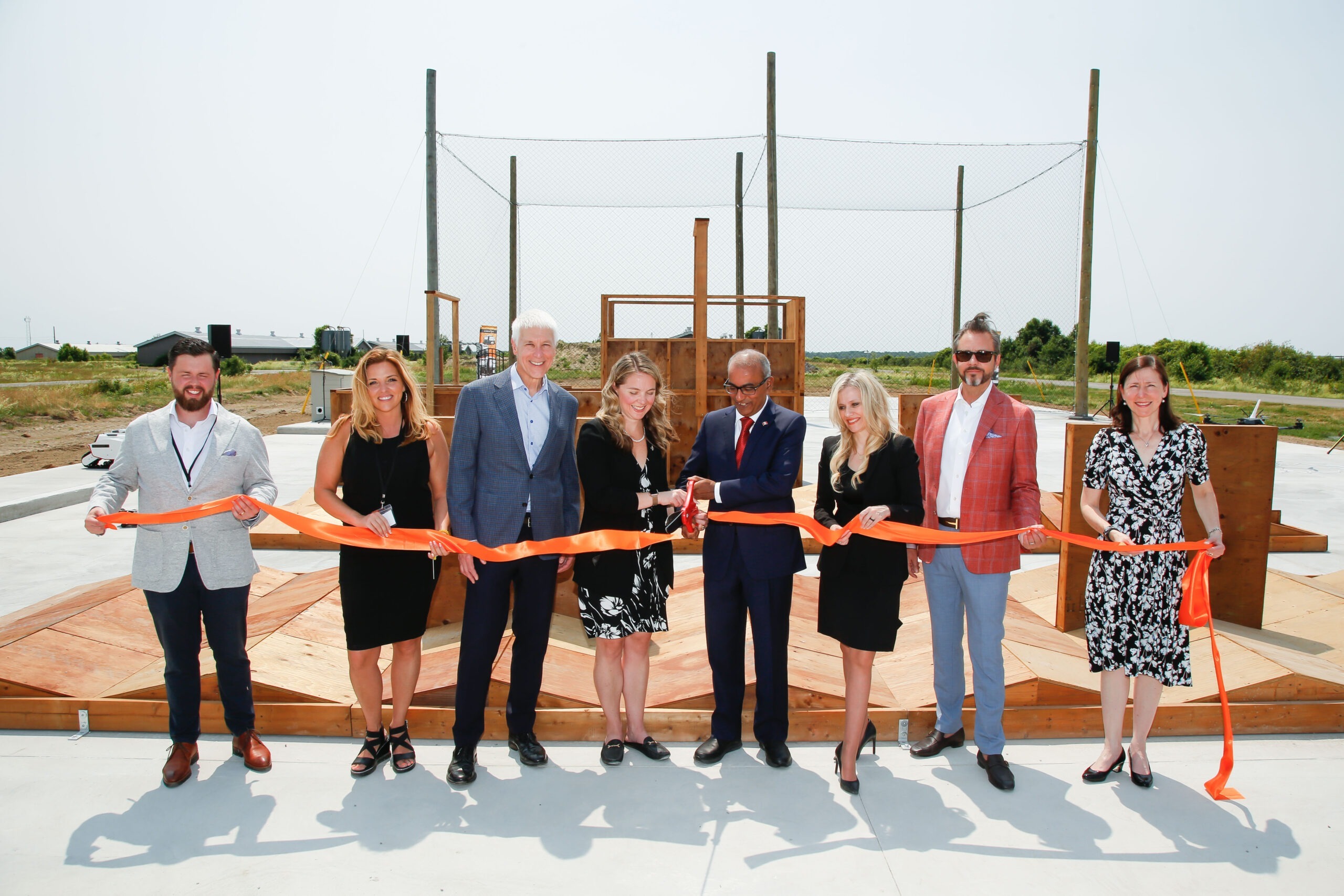
BENEFITS OF DARTT
Well, there will be many.
Manufacturers can put their ground robots and drones to the test in a safe environment. Timed courses can be used to measure skills improvement, such as the NIST bucket test – where drone pilots must precisely hover a drone and angle a gimbal to reveal numbers, letters and symbols placed in the bottom of angled buckets (particularly useful for First Responders and Search and Rescue operators). Robots can be tested for their ability to navigate sand, gravel, other uneven surfaces – even stairs and variable inclines.
Developers, InDro included, can test the ability of their own products in multiple environments in a single session. For those in the R&D world in particular, access to DARTT may well speed a product’s path to market.
“It will be First Responders, it will be SMEs (Small and Medium-sized Enterprises), but it will also be regulators,” said InDro CEO Philip Reece at the launch.
“They’ll want to be assured that the equipment that we put out in the field is safe, is tested – that it will do what it’s supposed to do every time. We’ve got SMEs now who are saying: ‘How can we get on site to test our equipment?'”
FIRST RESPONDERS
Mike Nolan, Chief of County of Renfrew Paramedic Service, also spoke at the opening. Chief Nolan started out with drones about 10 years ago, running tests alongside Philip Reece out on farms in the very early days of UAVs. Since then, the technology has evolved exponentially – and drones are now considered an indispensable part of the toolkit of First Responders.
Chief Nolan sees great value in DARTT, and believes the role drones and ground robots play in his field (and others) will only grow.
“There isn’t a week that goes by when paramedics, police officers, firefighters aren’t using a drone for the search and rescue of individuals across Canada,” he said.
“This (DARTT) is an ideal playground for professionals. This allows us to be able to develop the technology, test the technology, work with our partners at NAV Canada, Transport Canada and others to be able to demonstrate that the acceleration of this technology is saving lives, and not putting lives at risk.”
Chief Nolan wasn’t the only speaker who saw the value of these tools.
“These are life-saving technologies,” said Sonya Shorey, VP of Strategy, Marketing and Communications with Invest Ottawa, Area X.O and Bayview Yards.
“These are technologies that will change the way we work, the way we operate, and how we deal with crises and disasters.”
Below: An InDro Sentinel tele-operated robot takes a splash in the water pool – which has three different depths of water.

AREA X.O
DARTT is a perfect fit with Area X.O – a private innovation hub founded and operated by Invest Ottawa. The facility is known for cutting-edge infrastructure, including roads designated for autonomous and remotely operated vehicles, complete with traffic lights, railroad crossings and smart sensors. Developers frequently test their products on those roads – but DARTT adds a completely new dimension for evidence-based evaluation.
“Ottawa is a global tech hub,” said Sonya Shorey. “Our region has the highest tech talent concentration in North America, ahead of Silicon Valley. There are more than 1750 technology companies, including smart mobility, drones and advanced robotics. And this facility is the first of its kind in Canada.”
In fact, it’s the first combined ground robot and drone testing/proving grounds in North America. And one of its big proponents is Area X.O’s Rebecca Thompson.
“This is a special day we have been working toward for many months,” said Thompson. “And this is just the beginning.”
Indeed, InDro is already working on highly specialised Micro-Credential courses that will be rolled out soon at DARTT. And the facility features a tether for the testing of drone taxis – part of the Jetson’s-like future that’s promised in the world of Advanced Air Mobility/Urban Air Mobility.
“We’ve built this site particularly for the future,” said Reece. “So Advanced Air Mobility…we’ve put a tethered system in here, so that we can bring that kind of equipment in and test it and know that it’s not going to fly away…”
Below: DARTT features a very large netted enclosure for safe testing of drones – and training of drone operators

INDRO’S TAKE
InDro was obviously deeply involved with this project from the outset. In fact, InDro’s Brian Fentiman – who had a career with the RCMP and has deep expertise in law enforcement drone training – designed the course after extensive research.
Now you might think: Of course InDro is going to be pleased – the company will be doing the training and DARTT is right outside its back door.
While that’s true, that isn’t really what excites us the most.
“I see this as a huge asset for the industry proper,” says InDro CEO Philip Reece. “SMEs wanting to test and quickly improve products will now have year-round access to a facility that meets NIST criteria – where they can easily quantify success and even setbacks. I truly believe it will help companies produce better products and get them to market more quickly. And that’s good for all of us.”
Interested in more information?
- Read more about DARTT here
- Read the joint Area X.O/InDro Robotics News Release here
- Get information on booking DARTT for testing or training here
We’ll have much more on this state-of-the-art facility in the days and weeks to come.

